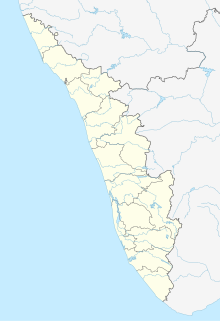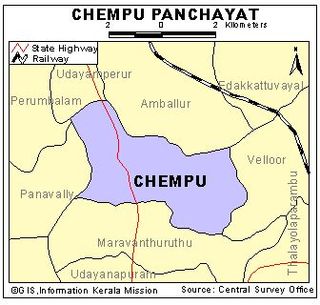
Kottayam is one of fourteen districts in the state of Kerala, India. Kottayam district comprises six municipal towns: Kottayam, Changanassery, Pala, Erattupetta, Ettumanoor, and Vaikom. It is the only district in Kerala that neither border the Arabian Sea nor any other states.

Meenachil is the north-eastern region of Kottayam district in Kerala, south India. The name originates from Meenakshi, the Dravidian goddess. Pala is the main city in Meenachil. The arterial river of the district is also named Meenachil.

Kumarakom is a popular tourism destination located near the city of Kottayam, in Kerala, India, famous for its backwater tourism. It is set in the backdrop of the Vembanad Lake, the largest lake in the state of Kerala.

Vaikom, IPA: [ʋɐjkːɐm], is a municipal town and a capital town of Vaikom Taluk, situated in the northwest of Kottayam district in the state of Kerala, India. The town is also noted for its role in the Indian independence movement for being the venue of Vaikom Satyagraham, a civil rights movement aimed at securing freedom of movement for all sections of society through the public roads leading to the Vaikom Shiva Temple.

Aymanam is a village in the Kottayam District of Kerala, India. It is about 4 km from the railway station in Kottayam along the road to Parippu, and 85 km from the Cochin International Airport. Aymanam is the setting for Arundhati Roy's 1997 novel The God of Small Things.

The Kerala backwaters are a network of brackish lagoons and lakes lying parallel to the Arabian Sea coast of Kerala state in southern India, as well as interconnected canals, rivers, and inlets, a labyrinthine system formed by more than 900 kilometres (560 mi) of waterways, and sometimes compared to American bayous. The network includes five large lakes linked by canals, both man made and natural, fed by 38 rivers, and extending virtually half the length of Kerala state. The backwaters were formed by the action of waves and shore currents creating low barrier islands across the mouths of the many rivers flowing down from the Western Ghats range. In the midst of this landscape there are a number of towns and cities, which serve as the starting and end points of backwater cruises. There are 34 backwaters in Kerala. Out of it, 27 are located either closer to Arabian Sea or parallel to the sea. The remaining 7 are inland navigation routes.

Vembanad, also known as Punnamada is the longest lake in India, as well as the largest lake in the state of Kerala. With an area of 2033 square kilometers and a maximum length of 96.5 km, it is the second largest Ramsar site in India only after the Sunderbans in West Bengal. Spanning several districts in the state of Kerala, it is known as Vembanadu Lake in Kottayam, Vaikom, Changanassery, Punnamada Lake in Alappuzha, Punnappra, Kuttanadu and Kochi Lake in Kochi. Several groups of small islands including Vypin, Mulavukad, Maradu, Udayamperoor, Vallarpadam, Willingdon Island are located in the Kochi Lake portion. Kochi Port is built around the Willingdon Island and the Vallarpadam island.

Kuttanad is a region covering the Alappuzha, Kottayam and Pathanamthitta Districts, in the state of Kerala, India, well known for its vast paddy fields and geographical peculiarities. The region has the lowest altitude in India, and is one of the few places in the world where farming is carried on around 1.2 to 3.0 metres below sea level. Kilimanjaro in Africa is the another place Kuttanadu is historically important in the ancient history of South India and is the major rice producer in the state. Farmers of Kuttanad are famous for Biosaline Farming. Food and Agriculture Organization (FAO) has declared the Kuttanad Farming System as a Globally Important Agricultural Heritage System (GIAHS).

Kettuvallam is a house boat widely used in the Indian state of Kerala. These have thatched roof covers over wooden hulls. The traditional kettuvallam is mainly used for promoting Kerala tourism.

Pathiramanal is a small island inMuhamma panchayat of Alappuzha district. The name Pathiramanal means 'midnight sand'. The scenic beauty of both sides of the lake as well as that of the island is mind blowing. It is home to many rare varieties of migratory birds from different parts of the world.

The MeenachilRiver flows through the heart of Kottayam district, Kerala state in southern India. 78km long, the river originates in the Western Ghats near Poonjar, flowing westward through the city of Kottayam and other towns like Poonjar, Teekoy, Erattupetta, Bharananganam, Pala, Mutholy, Cherpunkal, Kidangoor and Kumarakom before emptying into the Vembanad Lake on the shore of the Indian Ocean.

Kainakary is a village in Kuttanad Taluk in Alappuzha District of the Indian state of Kerala.

Kottayam, IPA: [koːʈːɐjɐm] is a city in the Indian state of Kerala. Flanked by the Western Ghats on the east and the Vembanad Lake and paddy fields of Kuttanad on the west, Kottayam is a place that is known for extraordinary qualities. It is the district headquarters of Kottayam district, located in south-west Kerala. Kottayam is located in the basin of the Meenachil River at an average elevation of 3 metres (9.8 ft) above sea level, and has a moderate climate. It is located approximately 155 kilometres (96 mi) north of the state capital Thiruvananthapuram.

Chempu is a village near Vaikom in Kottayam, Kerala, India. It is bounded by the shores of the Lake Vembanad, and is crossed by various distributaries of the River Muvattupuzha.

Kerala, a state situated on the tropical Malabar Coast of southwestern India, is one of the most popular tourist destinations in the country. Named as one of the ten paradises of the world by National Geographic Traveler, Kerala is famous especially for its ecotourism initiatives and beautiful backwaters. Its unique culture and traditions, coupled with its varied demography, have made Kerala one of the most popular tourist destinations in the world. Growing at a rate of 13.31%, the tourism industry is a major contributor to the state's economy.

Mangalavanam is an ecologically sensitive area situated at the centre of the Indian city of Kochi, covering about 2.74 hectares. It also houses a shallow tidal lake connected with Kochi backwaters by a canal. It is situated behind the Kerala High Court building. It is a nesting ground for a large variety of migratory birds and supports many types of mangroves. The Managalavanam is often regarded as the "green lung of Kochi", considering its role in keeping the city's air pollution under check. The area is a roosting place for many kinds of resident and migratory birds.

Tourist Resorts (Kerala) Ltd or (TRKL) is a Government of Kerala undertaking under Kerala Tourism Department, established in August 1989 to promote tourism investment and to develop Tourism infrastructure in the Indian state of Kerala. TRKL was conceived to identify tourism infrastructure needs of the state and bridge any identified gaps. Kerala is today growing at an amazing pace in tourism, adhering to the principles of indigenousness, environmental sustainability and community participation. Kerala's beaches, hill stations, backwaters, wildlife sanctuaries, historical monuments, etc. attract foreign as well as domestic tourists.

The following outline is provided as an overview of and topical guide to Kerala:
Waterways have always been an important mode of transport in Kerala. The total length of navigable route in Kerala was 1,900 kilometres and the navigable rivers constitute about 54 per cent of the waterways. The 41 West-flowing rivers together with the backwaters are an integrated part of the inland navigation system in Kerala. In Kerala water transportation through these channels are mainly small distant passenger services, informal country boats,freight transportation to PSU's such as Fertilisers and Chemicals Travancore, Kochi etc.





















